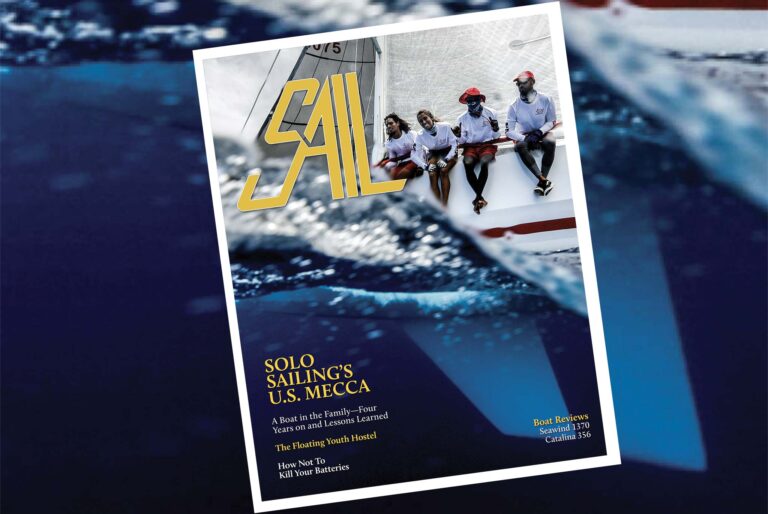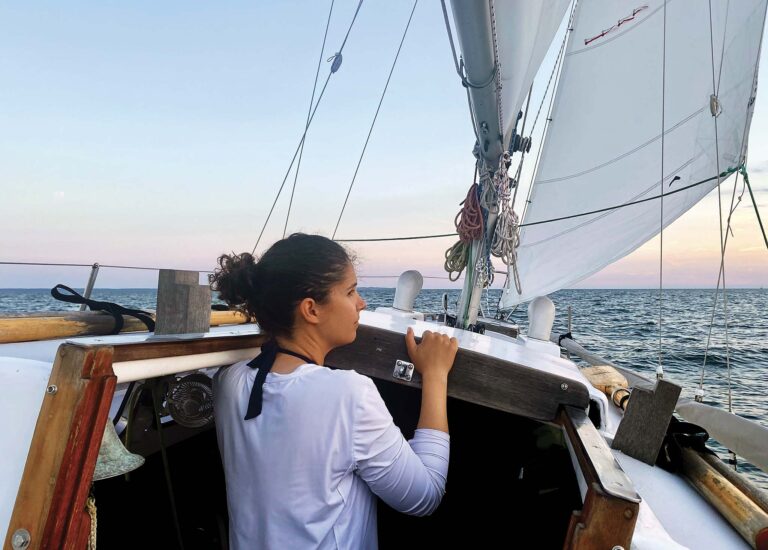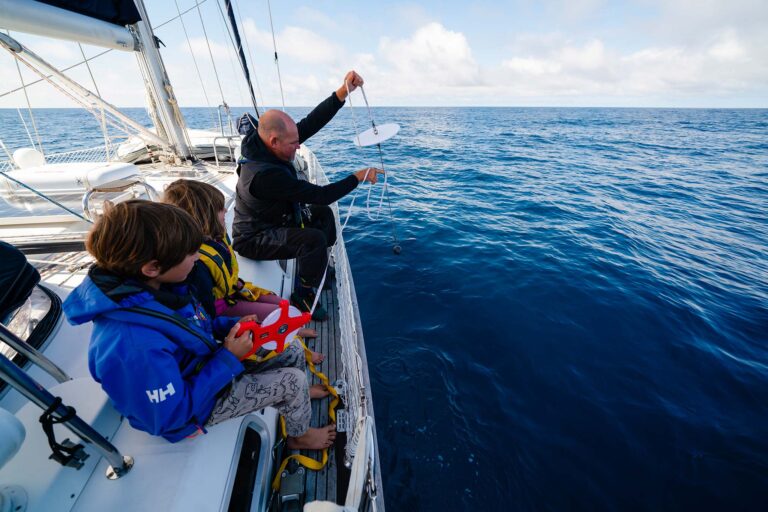It used to be that sailors looking to keep their boats moving in light air had fairly limited options. A big overlapping genoa flown from a fixed headstay was the weapon of choice when trying to get upwind in a zephyr. Turning downwind, it was a question of setting a balky hard-to-handle symmetric spinnaker on a pole.
Serious racing sailors were never bothered by this. They were happy to change small jibs for genoas (and back again), as conditions required, and prided themselves on their ability to handle big symmetric kites in most any situation. But cruising sailors, a notoriously lazy lot, fell into a rut of sorts. Once roller-furling headsails became the norm, cruisers generally liked to have a small to midsized genoa permanently hoisted on their headstay furling rod and almost always left spinnakers in their bags. Once the wind went light, more often than not, they were content to switch on the “iron jib” and motor directly to their destination.
These days, happily, we are in the midst of a new Golden Age. Sailmakers, riggers and hardware manufacturers have introduced a number of innovative sails and sailhandling systems that make it easier than ever to make good progress under sail when the breeze gets soft. Now there is little excuse for letting your engine do the work of getting you where you want to go.
HAIL THE A-SAIL
The Lazy Man’s Spinnaker
A symmetric spinnaker on a pole requires lots of running rigging, but a modern asymmetric spinnaker (or A-sail), like a jib or genoa, is controlled by a single pair of sheets. Like conventional spinnakers, asymmetrics are large lightweight nylon sails that have a full shape and fly free, so they generate lots of power in light apparent winds. Unlike symmetric spinnakers, however, they have a distinct leech and luff and their tacks are secured to a fixed point on a boat, either at the bow or on a bowsprit.
Because A-sails are not held out square to the wind on a pole, past a certain point as a boat turns downwind they are blanketed by the mainsail. Effective apparent wind angles generally range from about 60 to 145 degrees. Rather than run dead downwind, it is therefore necessary with an A-sail to “tack downwind” on a series of broad reaches. On an appropriate boat with minimum wetted surface area, sailing these hotter angles will be as fast, or faster, than running off on a more direct course.
Gybing an A-sail is easier than gybing a symmetric kite, but still requires some effort and crew work. The sail’s lazy sheet can be led either “inside,” between the sail and the headstay, or “outside,” forward of and around the sail’s luff. During an inside gybe the body of the sail must pass between the luff and headstay, and it’s usually necessary for crew forward to smartly haul the new working sheet aft to make sure the sail gets through without twisting. During an outside gybe, the sail flies forward of everything and things generally go more smoothly. In very light conditions, however, the sail may need help getting around itself.
Most cruisers, and some racers, like to use a spinnaker snuffer or sock to control an A-sail when hoisting and dousing it. Essentially, this is a long tube of light fabric that fits over the sail like a giant condom. There is a solid skirt at the bottom and a continuous control line that runs to the head of the snuffer and back again. The sail is raised inside the snuffer, a tug on one side of the line pulls the skirt up, and the sail is unleashed. To recover it again, you simply release the A-sail’s sheet and pull the snuffer down over it. You can then bring the sail down to the deck in a controlled manner.
VIDEO: THE PARASAILOR
To work well, a snuffer must be properly designed. The control line should run in a segregated sleeve to keep it from getting twisted up with the sail. The line’s block at the head of the snuffer should run smoothly, and the line itself should have a soft finish so it doesn’t cut hands too easily. The body of the snuffer should not be nylon, or it will adhere to the sail when wet. The fabric should be light with a soft finish to reduce friction and porous so air isn’t trapped inside. The head of the snuffer should have a short pennant and swivel so there’s room for the bunched-up snuffer to ride over the sail, and so the sail can pivot freely.
More recently, hardware manufacturers have begun developing furling systems that work with asymmetric spinnakers. These promise to make the launching and dousing of powerful downwind sails easier than ever. For more details on the mechanics of these systems see “Furl it Up” on page 62.
LUFF-FURLING HEADSAILS
The Name Game
In between spinnakers and conventional genoas there are now many different light-air headsails with mysterious names. What these sails have in common is the ability to furl up on their own luffs, which essentially have spinal chords composed of either a single untwistable high-modulus luff rope or a pair of much lighter high-modulus luff lines running side by side. Thanks to the advent of lightweight easy-to-handle continuous-line furlers, all these sails can be hoisted and doused, or rolled, up on themselves.
In most cases it is necessary to roll up and then unroll these sails again when tacking or gybing. This is normally less bothersome than it sounds, as modern continuous-line furlers are remarkably efficient and friction-free. Though they cannot be reefed, most luff-furling headsails can be left rolled up and hoisted in place, at least in moderate conditions, when not needed. This makes them extremely versatile, and on many modern boats they have now entirely replaced large overlapping genoas. Here’s a guide to their confusing nomenclature:
Code Zero sail
Originally this was a rule-beating flat-cut upwind sail that rated as a spinnaker in an inventory of racing sails. Technically, the mid-girth measurement of a true Code Zero sail must equal 75 percent of its foot length, with positive area in both the luff and leech. Today the term is commonly misused to refer to any large flat-cut luff-furling laminated sail that can fly at very closehauled apparent wind angles.
Jib-top and screecher
These are large flat-cut headsails with rather high clews. Monohull sailors tend to call them jib-tops; multihullers call them screechers. Normally they are made of lightweight laminated fabric, in which case they can fly at very close-hauled angles (up to about 25 degrees, depending on the boat), or nylon, in which case angles are somewhat wider (up to approximately 40 degrees). They may also be made of light Dacron.
Multi-Purpose Genoa and Universal Power Sail
Normally referred to acronymously (MPG and UPS), these are simply large luff-furling headsails made of light Dacron or nylon. How high you can point with them depends on the material and how flat they are cut, which can vary. Some may be indistinguishable from a jib-top or screecher; others are more like reaching sails.
Gennaker, reacher and drifter
These are generally made of nylon and have a somewhat fuller cut, which limits their upwind capability (to angles of about 45 or 50 degrees), but makes them excellent reaching sails. Some gennakers may be made of light Dacron
PARASAILOR: A KITE WITH A HOLE IN IT
Billed as “the most unexciting spinnaker ever,” the Parasailor is a symmetric sail that can be set with or without a pole. What makes it uique—and easier to handle than a conventional kite—is an enormous mid-girth aperture with a horizontal wing set in it. This generates lift and stabilizes the sail, making it less likely to collapse on itself. The aperture also acts aas a vent and “pressure relief valve” that allows gusts of wind to pass through the sail. The sail’s stability and the lift it generates maredly reduces a oat’s tendency to yaw, pitch or broach under it, allowing a crew to cleat the sheet and steer by authopilot. According to ISTEC (istec.ag), the sail’s manufacturer, the Parasailor can be flown at apparent wind angles ranging 70 to 180 degrees.









